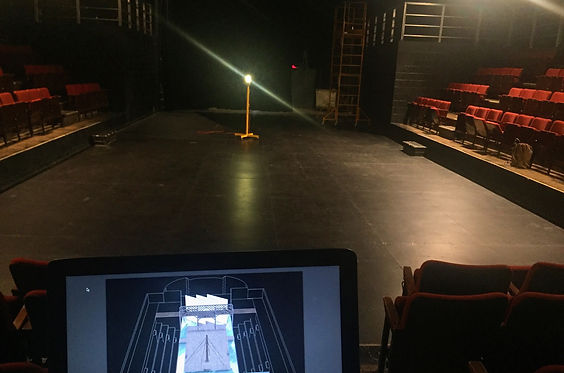A Designer, art creator










Scenic Designer
Argonautika
The Pavilion Theatre
The Pennsylvania State University
2017
Directed by Steven Snyder
Lighting Design by Jen Minor
Costume Design by Austin Rausch
Puppet Design by Regina Joslin
Penn State Centre Stage put on the production of Argonautika in the fall semester of 2017.
I designed the show the summer going into my senior year, collecting research, sketching, 3D drafting, creating drafting plates, and making a rendering. During my fall semester, I completed the paint elevations, the model box, and a 3D drafted fly-through movie as seen to the left.
Argonautika is rooted in a greek mythology with a modern twist. It is about an epic tale of triumphant and defeat. The story follows Jason and the Argonauts as they journey to find the golden fleece, but the real star of the show revolves around the women who shape their journey.. I chose to design a set that would mimic the ancient Greek boats as well as be a diverse setting that could transfer back and forth from islands, the desert, the palaces, and the ship. Creating an environment that changed rapidly with multiple locations occurring at the same time was an essential component of the design being functional.
The bridge functioned as a ship in profile where Argonauts could stand above and below while other scenes took place on the deck, and it functioned as an area for kings to speak down to their kingdoms. The triangular railing design mimics that of Greek boat supports and helped to show the dominance and power of the Argonauts, the Kings, and the goddesses. Ladders were located on either side of the center extension of the bridge for easy access up and down.
The floating deck came from the inspiration of a floating dock. This was the main acting area. The area around the floating deck was used to isolate more intimate moments in the show. As this theatre space is unique in that the audience seats are surrounding the stage, I wanted the actors to be close to the audience during the more intimate moments to allow for the audience to feel apart of the moments. LED lights were located under the cantilevered section of the deck to make it look as though it is floating.
Over the course of the show, the set transformed from a simple, sleek wood structure to a full ship. 10'x12' sails were hoisted up behind the bridge, a 12' tall mast was carried out by actors and placed on stage, and ropes were clipped from the bridge and the mast to complete the look. Towards the end of the show the mast hinged to collapse on the main character. The ropes were used as props for a few scenes and could be easily unhooked and hooked when needed.
Inside of the floating deck two benches were lifted out by actors and when not being used they were flipped back inside of the deck. A trap was built from the basement of the building to the top of the floating deck. A mounted platform made from expanded steel and plexi-glass, stairs, and a ladder were used to get the actors, props, and puppets safely and easily in and out of the trap. The expanded steal and plexiglass allowed for lighting to uplight actors. The design for the trap was complicated as there were parameters that had to be followed which prevented most productions from using a trap in that space. Luckily because the design involved no electrical work, it was allowed.
The paint treatments were mostly wood grained, except for the deck which was a topographical map of the original journey of Jason and the Argonauts. The map was painted in blues and greens to show both land and water.
Gold shimmer was sprayed on top of the downstage bunkers to show where the goddesses "lived". From these positions the goddesses narrated the entire show, looking over the stage.




